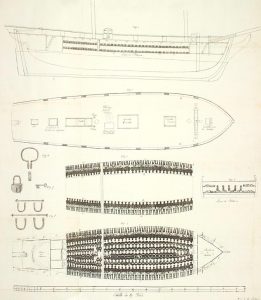Slavery and The Push for Freedom
ENG 302 – Prof. Kappes/Lehman College March 26, 2018
Sibyl Randolph
Slavery and The Push for Freedom
Residing in “the belly of the beast” means to live in the heart of a dangerous place or to be locked-up in an institutionalized system. That is what the transatlantic slave trade was to the enslaved Africans in the 17th and 18th centuries who were transported on slave ships to the West Indies and the Americas solely for economic gain. A visual of the conditions of the enslaved is shown in an illustration from the New York Public Library’s The Schomburg Center for Research in Black Culture “In Motion: The African Migration Experience” digital collection on Slavery. The illustration, titled “The Slave Ship”, gives insight on the inhumanity Africans experienced during the voyage. Comparatively, The Interesting Narrative of The Life of Olaudah Equiano or Gustavus Vassa (1794) provides a first-hand account of what is was like to be transported in the bowels a slave ship. Equiano’s narrative gives voice to the illustration of the slave ship because it highlights the emotional and physical trauma the Africans were forced to endure “locked up” in “the belly” of a strange vessel upon an ocean that some had never seen before. Both the illustration and Equiano’s narrative convey the horrific conditions and inhumane treatment experienced by the enslaved African’s who were forced to endure transatlantic slave ship voyages. Additionally, the illustration of the interior of the slave ship asserts that it may have also served as a blueprint or architectural rending of the ship and the inclusion of the lock and key in the blueprint as accessories passively depicts the horror of slavery and symbolizes the fate of the people being locked into bondage.

Looking closely at the New York Public Library’s illustration you see partially clothed enslaved people crammed so closely together that there was no possible way that they could move or become comfortable. The ship has two cargo hold areas and the blueprint details exactly how each person was forced to lay, sit, or kneel for the entire journey. The illustration also shows the shackles, restraints, and locks used to restrain the feet and necks of the enslaved. The fetters served to inhibit body movement and to break the spirit of the people and cramming together of the “cargo” served to increase financial gain.
In Equiano’s narrative, he articulates how he and his sister were kidnapped from their family’s village and sold into slavery. Initially, Equiano’s slave experience followed the African society’s cultural customs where it was the norm to treat slaves humanely. Subsequently, he was separated from his sister and sold several times during his enslavement in Africa. He eventually arrived on the coast of Africa, which he had never seen before, and was sold into the transatlantic slave trade. Equiano states, “When I arrived on the coast was the sea, and a slave-ship, which was then riding at anchor, and waiting for its cargo. These filled me with astonishment, which was soon converted into terror, which I am yet at a loss to describe, nor the then feelings of my mind” (55). The loss of words Equiano has at the sight of the slave ship quickly turns to horror when he realizes that the state of slavery in African culture is brutally different from the condition of slavery aboard a slave ship. Equiano speaks of how the enslaved were crowded close together in the cargo area in a very hot climate which caused the air to become loathsome and brought on infectious illnesses. Equiano further highlights the deplorable conditions when he laments, “This wretched situation was again aggravated by the galling of the chains, now become insupportable; and the filth of the necessary tubs, into which the children often fell, and were almost suffocated. The shrieks of the women, and the groans of the dying, rendered the whole a scene of horror almost inconceivable” (58). These descriptions by Equiano give further insight and proof of the excruciating emotional and physical trauma the enslaved were subjected to during the transatlantic voyage. Equiano’s detailed and graphic accounts of the unimaginable and inhumane treatment of the enslaved may have been his way of reaching out to his European audience in an effort to make a strong case against slavery.
In conclusion, Equiano’s narrative of the horrors of the transatlantic slave trade provides many concrete and vivid details of the slave trade and it gives voice to the illustration or blueprint of the voyage, which depicts the horrors in a non-emotional way. As a result, Equiano’s narrative made a strong case for the abolishment of slavery and his personal promotion of the book reinforced his goal of convincing his audience to advocate for the abolishment of the slave trade in the British colonies.

